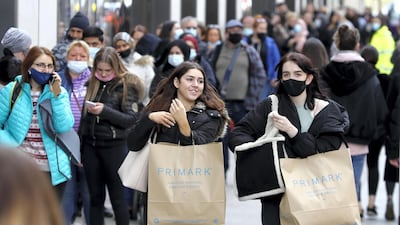UK inflation more than doubled to 1.5 per cent in April on the year marking the start of what the Bank of England hopes will be a temporary surge in prices as the economy reopens from the latest round of restrictions.
The sharp rise in Consumer Price Inflation followed a 0.7 per cent annual increase in March, the Office for National Statistics said, with the jump driven mainly by a rise in domestic energy prices along with clothing and footwear and the cost of petrol.
As the UK’s reopening allows consumers to start splurging cash, the BoE expects inflation to exceed its 2 per cent target and reach 2.5 per cent by the end of this year.
ONS chief economist Grant Fitzner said April's inflation surge was caused by the rise in prices this year compared with the falls seen at the start of the pandemic last year.
“This was seen most clearly in household utility bills and clothing prices,” Mr Fitzner said.
“As the price of crude oil continues to rise, this has fed through to the cost of motor fuels, which are now at their highest since January 2020.”
On a monthly basis, the CPI rose by 0.6 per cent in April, after a 0.3 per cent increase in March. This compares with a fall of 0.2 per cent in April last year.
The 9 per cent surge in gas and electricity prices drove April's inflation rise, the ONS found, while clothing and footwear prices rose 2.4 per cent after a 1.6 per cent drop a year ago.
Prices charged by manufacturers rose 3.9 per cent in the year to April, the biggest rise in more than two years, while a measure of input prices paid for raw materials by factories rose 9.9 per cent from a year earlier, the fastest rate since February 2017.
BoE governor Andrew Bailey on Tuesday said there was no strong evidence that higher prices paid by manufacturers were feeding through to consumer prices.
However, he said the central bank would "be watching this extremely carefully" and take action if necessary.
Laith Khalaf, financial analyst at AJ Bell, said the price rises were in key areas where it is hard for consumers to control spending, such as transport, clothing and household energy.
“At current levels, inflation is nothing to fret about but there is rising concern that the fiscal and monetary response to the pandemic has sown the seeds of an inflationary scare farther down the road,” Mr Khalaf said.
“For the moment, the BoE is dismissing consumer price increases as a natural bounce back from the depths of the pandemic last spring. But the economic recovery could be a Trojan horse, smuggling inflation into the UK right under the nose of central bankers.”
UK inflation is set to rise further over the months ahead with prices for air travel, domestic accommodation and package holidays expected to leap in response to rebounding consumer demand, Samuel Tombs, UK economist at Pantheon Macroeconomics said.
The end of the VAT cut to help hospitality businesses through the Covid-19 crisis from October will also boost prices, although the end of the furlough scheme and an accompanying rise in unemployment may ease BoE fears over prices running out of control, he said.
Despite the rising inflation rate, the UK was still behind the US, where the latest reading came in at 4.2 per cent.
Meanwhile, eurozone inflation rose 1.6 per cent on the year in April because of a sharp rise in the costs of energy and services, according to the European Union's statistics office Eurostat, with a 0.6 per cent increase on March.
“The BoE has made it clear that it will tolerate inflation rising modestly above target, without pulling the trigger on interest rate rises,” Mr Khalaf said.
“However, if inflation looks like it’s going to get a significant foothold, markets will take matters into their own hands and raise borrowing costs across the economy.”
Meanwhile, inflationary fears have already started to trickle into markets, with the 10-year gilt now yielding 0.9 per cent, up from 0.2 per cent at the beginning of the year.
The UK experienced soaring inflation in the 1970s and ‘80s, but the BoE dismissed recent increases in 2008 and 2011 as temporary, despite prices surging close to 5 per cent in both instances.
Andy Haldane, the BoE’s departing chief economist, said the momentum behind the recovery was strong enough to risk a damaging wave of inflation.
If a sustained inflationary period is realised, Mr Khalaf said it would be a paradigm shift from 25 years of extremely benign price rises, “which have provided comforting mood music for stocks and bonds”.
“Investors don’t need to hit the panic button just yet, but they do need to factor the potential for higher rates of inflation into their plans. Where inflation is concerned, it’s better safe than sorry," he said.


